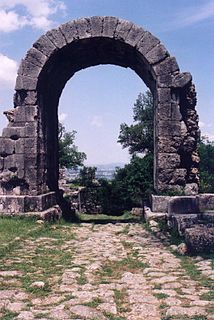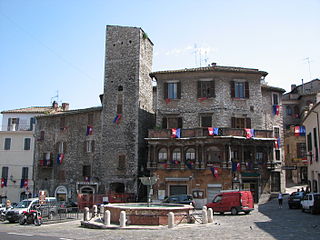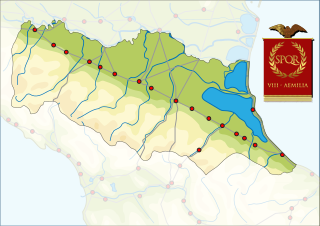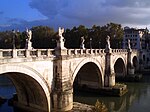
The Via Flaminia or Flaminian Way was an ancient Roman road leading from Rome over the Apennine Mountains to Ariminum (Rimini) on the coast of the Adriatic Sea, and due to the ruggedness of the mountains was the major option the Romans had for travel between Etruria, Latium, Campania, and the Po Valley. The section running through northern Rome is where Constantine the Great had his famous vision of the Chi Rho, leading to his conversion to Christianity and the Christianization of the Roman Empire.

Narni is an ancient hilltown and comune of Umbria, in central Italy, with 19,252 inhabitants (2017). At an altitude of 240 m (787 ft), it overhangs a narrow gorge of the Nera River in the province of Terni. It is very close to the geographic center of Italy. There is a stone on the exact spot with a sign in multiple languages.

Spanish Town is the capital and the largest town in the parish of St. Catherine in the historic county of Middlesex, Jamaica. It was the Spanish and British capital of Jamaica from 1534 until 1872. The town is home to numerous memorials, the national archives, and one of the oldest Anglican churches outside England.

The Via Aemilia was a trunk Roman road in the north Italian plain, running from Ariminum (Rimini), on the Adriatic coast, to Placentia (Piacenza) on the river Padus (Po). It was completed in 187 BC. The Via Aemilia connected at Rimini with the Via Flaminia, which had been completed 33 years earlier, to Rome.

Regio VI Umbria is the name for one of the 11 administrative regions into which the emperor Augustus divided Italy. The main source for the regions is the Historia Naturalis of Pliny the Elder, who informs his readers he is basing the geography of Italy on the descriptio Italiae, "division of Italy," made by Augustus. The Regio Sexta is called Umbria complexa agrumque Gallicam citra Ariminium, "Umbria including the Gallic country this side of Rimini."

Carsulae is an archaeological site in the region of Umbria in central Italy. It is located approximately 4 kilometres (2.5 mi) north of San Gemini, a small comune in the province of Terni.

The Pons Fabricius or Ponte dei Quattro Capi, is the oldest Roman bridge in Rome, Italy, still existing in its original state. Built in 62 BC, it spans half of the Tiber River, from the Campus Martius on the east side to Tiber Island in the middle. Quattro Capi refers to the two marble pillars of the two-faced Janus herms on the parapet, which were moved here from the nearby Church of St Gregory in the 14th century.

The Arch of Augustus was the triumphal arch of Augustus, located in the Roman Forum. It spanned the Via Sacra, between the Temple of Castor and Pollux and the Temple of Caesar, near the Temple of Vesta, closing off the eastern end of the Forum. It can be regarded as the first permanent three-bayed arch ever built in Rome.

The Pons Cestius is an ancient Roman bridge connecting the right bank of the Tiber with the west of the Tiber Island in Rome, Italy. In Late Antiquity, the bridge was replaced and renamed the Pons Gratiani. It is also known as the Italian: Ponte San Bartolomeo, lit. 'Bridge of Saint Bartholomew'. No more than one third of the present stone bridge is of ancient material, as it was entirely rebuilt and extended in the 19th century, after numerous earlier restorations.

The Campo Iemini Venus is a marble sculpture of the Venus Pudica/Capitoline Venus type. It was unearthed in the spring of 1792 among other sculptures in the excavation of a Roman villa at Campo Iemini, near Torvaianica, in Lazio. The dig was directed by the English dealer in Roman antiquities Robert Fagan (1761-1816) under the patronage of Prince Augustus, the Duke of Sussex in partnership with Sir Corbet Corbet. At the time of its discovery the English in particular found it superior to the Capitoline Venus. After restoration in Rome it was shipped to London, where Prince Augustus gave it to his brother the Prince Regent, who set it up at Carlton House. After his death, when Carlton House was replaced by a terrace of houses, William IV donated it to the British Museum.

The Pons Aemilius, today called Ponte Rotto, is the oldest Roman stone bridge in Rome, Italy. Preceded by a wooden version, it was rebuilt in stone in the 2nd century BC. It once spanned the Tiber, connecting the Forum Boarium with Trastevere; a single arch in mid-river is all that remains today, lending the bridge its name Ponte Rotto.

The Bridge of Tiberius or Bridge of Augustus is a Roman bridge in Rimini, Italy. The bridge features five semicircular arches made of white Istrian stone with an average span length of ca. 8 m. Above the arches lied niches framed with pilasters carrying entablatures and pediments. They were framed on the arch bridge's walls. Modillions supported cornices were covered by a coping at the top. An inscription commemorating the construction of the bridges was located near the coping. Construction work started during Augustus' reign and was finished under his successor Tiberius in 20 AD; an inscription thus calls the structure as "given by both emperors". The bridge was the only crossing of the Marecchia not destroyed by the retreating German army during the Battle of Rimini as it was judged militarily pointless. The bridge is still open to pedestrian and vehicular traffic, with the exception of heavy goods vehicles.
The Ponte San Lorenzo is a Roman bridge over the river Bacchiglione in Padua, Italy. Constructed between 47 and 30 BC, it is one of the very earliest segmental arched bridges in the world. It is also notable for the slenderness of its piers, unsurpassed in antiquity.

The Ponte Nomentano is a Roman bridge in Rome, Italy, which carried the Via Nomentana over the Aniene. Having lain outside the city limits for most of its history, the picturesque bridge is noted for its medieval bridge tower, which served to protect this important northern approach to Rome.

The Ponte Salario, also called Ponte Salaro during the Middle Ages, is a road bridge in Rome, Italy, whose origins date back to the Roman period. In antiquity, it lay outside the city limits, 3 km north of the Porta Collina, at the point where the Via Salaria crossed the Aniene, a tributary of the Tiber. The visible side arches are assumed to originate from the first stone structure built during the 1st century BC.

George Cooke, was an English line engraver.

James Hakewill (1778–1843) was an English architect, best known for his illustrated publications.

The Arch of Augustus is a gate in the former city wall of Rimini, Italy. The arch was dedicated to the Emperor Augustus by the Roman Senate in 27 BC and is one of the oldest Roman arches which survives to this day. It signaled the end of the via Flaminia, which connected the cities of Romagna to Rome, and spans the modern Corso d'Augusto, which led to the beginning of another road, the via Emilia, which ran northwest to Piacenza.

Via dei Coronari is a street in the historic center of Rome. The road, flanked by buildings mostly erected in the 15th and the 16th century, belongs entirely to the rione Ponte and is one of the most picturesque roads of the old city, having maintained the character of an Italian Renaissance street.

The Lucano bridge is a Roman stone bridge over the Aniene river in the Province of Rome, Italy, on the via Tiburtina. Coming from the direction of Rome, the bridge is found after Tivoli Terme and before Hadrian's Villa. This bridge was part of the project for the most endangered monuments of the World Monuments Fund for the year 2010.






















